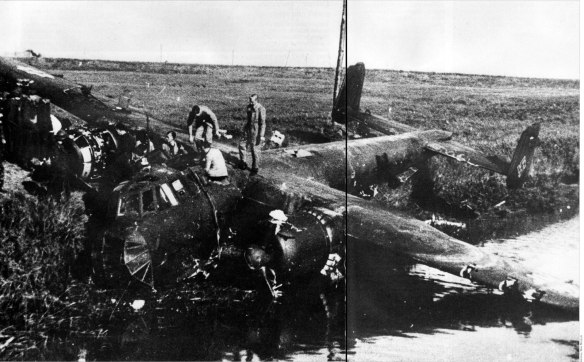Dornier Do 217 5.KG2 (U5+DN) Dora Nordpol Gunther Dolenga 12th Oct 1941-01
MEACON. British codename for transmitters located in England and designed to broadcast signals to interfere with enemy navigation beacons. By August 1940, 80 Wing had built nine MEACONS, part of the ASPIRIN antidote for HEADACHE.
ASPIRIN. Royal Air Force codename for the transmitters across the country employed to disrupt the Luftwaffe’s navigational beams that guided bombers to their targets in England. Some 2,000 personnel of 80 Wing operated 15 ASPIRIN sites, the electronic countermeasures taken to jam the enemy signals codenamed HEADACHE.
HEADACHE. British World War II generic codename for the countermeasures taken to bend the navigational beams used by Luftwaffe bombers.
November 6, 1940
A Luftwaffe bomber is brought down by a British radio beacon sending signals which convince the pilot that he is over France. This may have been a result of the “Meaconing” subterfuge, set in operation in August 1940. “Meaconing” is a system of receiving radio beacon signals and rebroadcasting them on the same frequency to confuse navigation. The meaconing stations cause inaccurate bearings to be obtained by aircraft or ground stations. The Luftwaffe used radio frequency beacons (200-500 kcs) for general navigation. These low power beacons are spread around German Occupied territory and transmit a continuous, omni directional carrier with a Morse identification on an allotted frequency. The position of these beacons (acting somewhat like invisible lighthouses) are marked on German charts, and by using normal direction finding equipment, and two beacons, aircrew could “fix” their position. The British set up receivers fitted with directional aerials (antennas) around the south and east coasts of England, and tuned into the enemy beacons. The received signals are sent by landline to counterfeit beacon transmitters elsewhere in Britain which radiated the German beacon signal on the same frequency but (obviously) from a false location. However the German signal is changed, the counterfeit transmitter continues to reproduce it faithfully and deceive the enemy aircrew’s direction finding equipment. This “masking” began in August 1940, and proves very successful. A slight refinement is possible when German aircrews request a bearing from their ground station. Then the aircraft transmitter would be re-radiated from a spurious ground transmitter which is DF’d by the ground crew, on the same frequency so that they might give a position report that could be as much as 100 miles (161 kilometers) in error.
The other Luftwaffe aid to navigation was a network of radio beacons, each with an indentifiable signal. Cross-bearings on two or more would give the bomber its precise location. Here again British countermeasures intervened with masking beacons, or ‘Meacons’, which reproduced the original signals. Many German bombers were led astray by these, and more than one was fooled into landing in England. On 14/15 February 1941 Heinkel pilot Hans Thurner, of KG 55, was even stated to have touched down on three English airfields in the same sortie. On each occasion he discovered his mistake in the nick of time, opened the throttles and made a hasty departure, eventually returning to base. He was awarded the Ritterkreuz on 6 August 1941. One of the few bomber pilots to fly entirely in the West, as Kommandeur I/KG 6 (Ju 188) he failed to return on 11 June 1944. He was awarded Eichenlaub posthumously on 20 September 1944.
